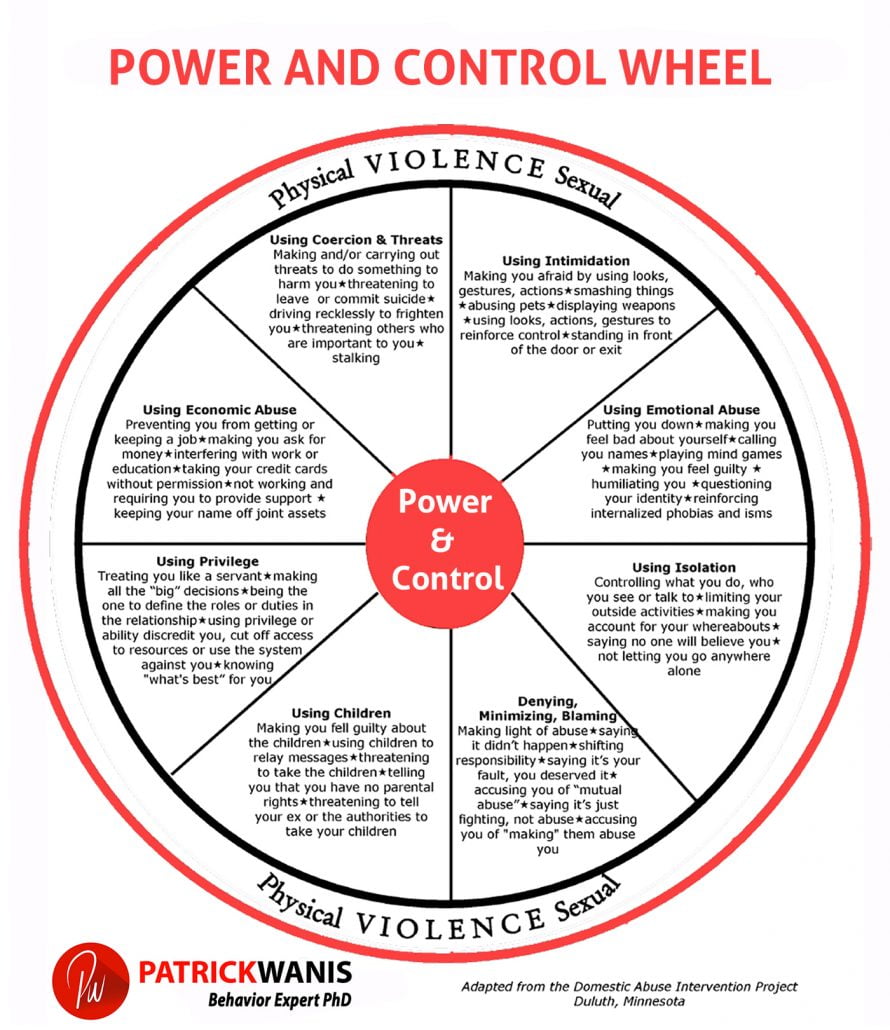In this week’s Success Newsletter, I would like to like to reveal the way to power & control, the 8 tactics abusive men use to control and dominate.
First a quick update:
The Breakup Quiz
Are you heartbroken, angry, lost, lonely, confused, depressed, or pining over your ex? How would you like to benefit from personalized advice, action steps and revelations? Take my Free Breakup Quiz and get your own personalized report.
20 Signs You Are Being Gaslighted! Psychological Abuse by Narcissists & Sociopaths
Gaslighting is Psychological abuse – manipulating someone to doubt their own memory, perception, and sanity. Watch the video
What is the ultimate objective of a man who abuses his partner?
Power and control!
Abusers seek to establish and maintain control over their partner.
“Men commit 86 to 97 percent of all criminal assaults and women are killed 3.5 times more often than men in domestic homicides.”
– Domestic Abuse Intervention Programs (DAIP)
And while the most obvious forms of domestic violence are physical and sexual assaults, there are 8 types of abuse that perpetrators of violence will use to achieve dominance over their partner, as well as to reinforce the threat of more physical or sexual assaults.
This can occur in dating or committed relationships such as marriage. If you don’t quickly identify the abusive behaviors of your partner, you can become a victim of the abuse and he will dominate and control you.
In 1984, Domestic Abuse Intervention Project (DAIP) in Duluth, Minnesota, created a model to help victims of domestic violence and to educate abusive men by identifying the most common tactics of abusive partners. They spent months interviewing women who had been battered. The results of those painful interviews is “The Power & Control Wheel” named after the primary goal of abusive men.
There are 8 key categories of abusive behaviors. They are not in any specific order, but neither are they random or arbitrary abusive tactics. Rather, they are purposeful and systematic strategies to further reinforce power and control over the woman. See Diagram below of the Power & Control Wheel.
Domestic violence including physical and sexual assaults can be initiated by either gender (including same sex relationships) but men are the primary perpetrators of domestic violence and battery.
Here are 8 behaviors used by abusive men for power & control.
1. Coercion And Threats – Power & Control Via Intense Fear
Making and/or carrying out threats to do something to hurt you
Threatening to leave you, commit suicide, or report you to welfare
Making you drop charges
Making you do illegal things
Driving recklessly to frighten you
Threatening others who are important to you
Stalking
2. Male Privilege – Power Via Degradation & Devaluing
Treating you like a servant
Making all the big decisions
Acting like the “master of the castle”
Being the one to define men’s and women’s roles, or your roles and duties in the relationship
Using privilege or ability to discredit you, cut off access to resources, or use the system against you
Knowing what’s “best for you”
3. Economic Abuse – Denial of Financial Resources
Preventing you from getting or keeping a job
Making you ask for money
Giving you an allowance
Taking your money
Interfering with work or education
Taking your credit cards without permission
Not working and requiring you to provide support
Keeping your name off joint assets
Not letting you know about or have access to family income
4. Using Children – Power & Control Via Fear For Children
Making you feel guilty about the children
Using the children to relay messages
Using visitations to harass you
Telling you that you have no parental rights
Threatening to take the children away; threatening to tell your ex or the authorities to take your children
5. Intimidation – Fear
Making you afraid by using looks, actions, and gestures to reinforce control
Smashing things
Destroying your property
Abusing pets
Displaying weapons
Standing in front of the door or exit

6. Emotional Abuse – Degrading and Humiliating
Putting you down
Making you feel bad about yourself
Calling you names
Making you think your crazy
Playing mind games
Humiliating you
Making you feel guilty
Questioning your identity
Reinforcing internalized phobias and isms
7. Isolation – Physical & Psychological Control
Controlling what you do, who you see and talk to, what you read, and where you go
Making you account for your whereabouts
Saying no one will believe you
Not letting you go anywhere alone
Limiting you outside involvement
Using jealousy to justify actions
8. Minimizing, Denying, And Blaming – Gaslighting & more
Making light of the abuse and not taking your concerns about it seriously
Saying the abuse didn’t happen
Shifting responsibility for abusive behavior – saying it’s your fault, you deserved it
Accusing you of mutual abuse
Saying it’s just fighting, not abuse
Accusing you of making “them” abuse you
All of the above 8 tactics of abusive men (adapted from The Power & Control Wheel – Duluth model and the model by National Sexual Violence Resource Center) are effective because they instill intense fear for survival of self and loved ones, and extreme or total dependence on the abuser.
If you have experienced abuse or trauma, you can resolve it rapidly and easily, and be set free of the pain with my SRTT process. Book a one-on-one session with me.
You can add to the conversation below.
I wish you the best and remind you “Believe in yourself -You deserve the best!”
Patrick Wanis Ph.D. Celebrity Life Coach, Human Behavior & Relationship Expert & SRTT Therapist
Anointed “The Woman Expert” by WGN Chicago, Patrick Wanis PhD is a renowned Celebrity Life Coach, Human Behavior & Relationship Expert who developed SRTT therapy (Subconscious Rapid Transformation Technique) and is teaching it to other practitioners. Wanis’ clientele ranges from celebrities and CEOs to housewives and teenagers. CNN, BBC, FOX News, MSNBC & major news outlets worldwide consult Wanis for his expert insights and analysis on sexuality, human behavior and women’s issues. Wanis is the first person ever to do hypnotherapy on national TV – on the Montel Williams show.

